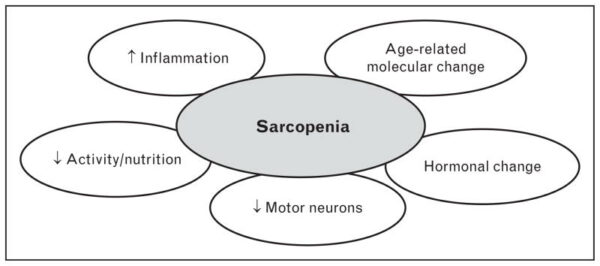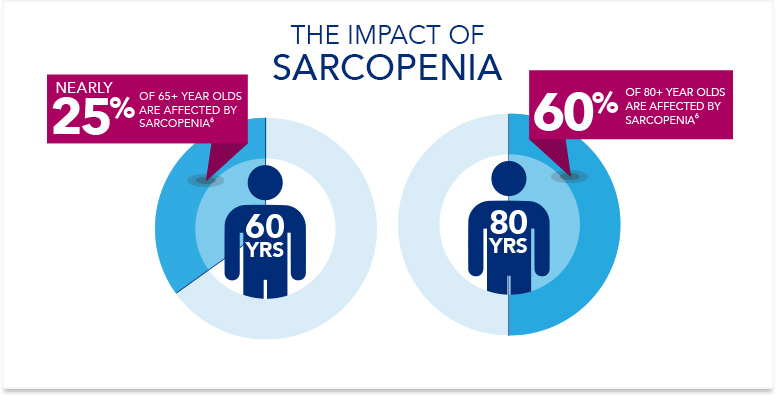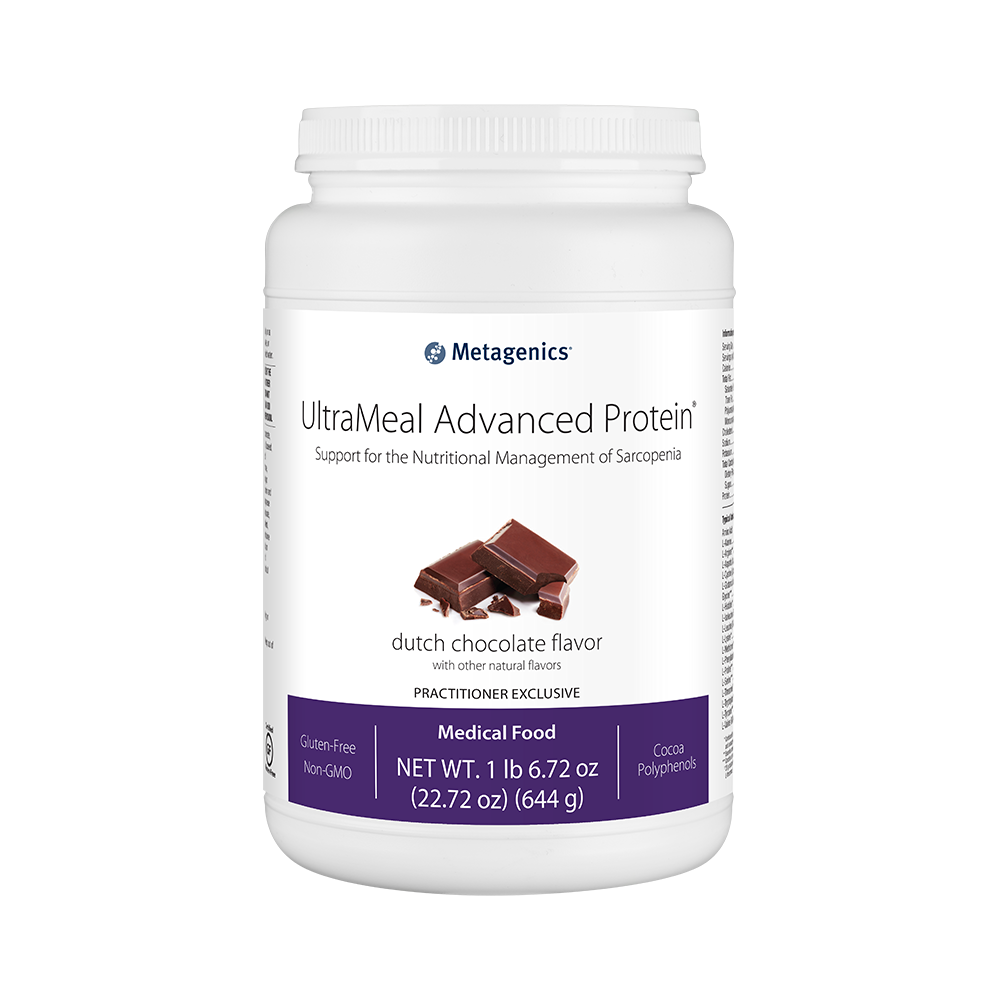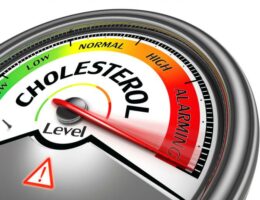Last updated on June 4th, 2021 at 08:49 am
In our ongoing series on medical foods we’re diving into Sarcopenia, what is it, why it’s serious and why anyone who is at risk should be working hand in hand with their healthcare practitioner to prevent it. If you missed “Medical Foods Part 1” feel free to jump to that article for some broad Medical Foods knowledge. We’ll also give some examples of products that are industry leaders in helping to support doctors and patients dealing with Sarcopenia. So first of all what is Sarcopenia?
Sarcopenia literally means “lack of flesh.” It’s a condition of age-associated muscle degeneration that becomes more common in people over the age of 50 although it can start earlier. Sarcopenia is caused by an imbalance between signals for muscle cell growth and signals for teardown. Your body normally keeps signals for growth and teardown in balance. As you age, your body becomes resistant to growth signals, resulting in muscle loss.
Beginning as early as the 4th decade of life, evidence suggests that skeletal muscle mass and skeletal muscle strength decline in a linear fashion, with up to 50% of mass being lost by the 8th decade of life [1].
Given that muscle mass accounts for up to 60% of body mass, significant changes to this important metabolically active tissue can have profound consequences on the older adult. The consequences of sarcopenia are often severe in older adults, as the strength and functional declines associated with sarcopenia can in turn contribute to a number of adverse health outcomes, including loss of function, disability, and frailty. 2,3,4
Sarcopenia is also associated with acute and chronic disease states, increased insulin resistance, fatigue, falls, and mortality.5-7 Of the chronic disease states, sarcopenia has been especially associated with rheumatologic conditions, especially rheumatoid arthritis (RA) in women.8
Sarcopenia often overlaps with malnutrition, especially in older patients.8 Different stages of sarcopenia may be used to help identify the severity of the condition, such as:
- Pre-sarcopenia: Characterized by reduced muscle mass. No reduction in muscle strength or physical performance
- Sarcopenia: Characterized by the presence of low muscle mass and low muscle function (strength OR performance)
- Severe sarcopenia: Characterized by reduced muscle mass and reduction in muscle strength9
Knowing and responding to the signs of malnutrition and/or sarcopenia are critical to patients receiving proper care. Sarcopenia has a pervasive, negative impact on patients’ quality of life and often leads to:
How To Tell If You Have Sarcopenia
Unfortunately the signs of Sarcopenia can be the same as many other diseases so if you are experiencing any of the symptoms below it’s best to consult your doctor right away to determine what the cause is.
Early signs of Sarcopenia can include feeling physically weaker over time or more difficulty in lifting familiar objects. If you’re walking more slowly or becoming exhausted more easily these could also be signs. Some clinics will use a hand grip strength test to help diagnose Sarcopenia. If you experience one or more of these and can’t explain why, talk to a health professional.
Getting Help
To fight Sarcopenia head on you need the right resources and the right team. The first step is working with a local and experienced health care practitioner who has successfully helped patients navigate Sarcopenia.
FIght Sarcopenia With Exercise
A number of studies have shown that strength and resistance training can help fight the negative effects of Sarcopenia including the lean body mass loss. Improving muscle strength, size and physical performance are key to fighting Sarcopenia.
Fight Sarcopenia With Nutrition
Proper balanced nutrition with a focus on protein consumption may reduce the risk and moderate the effects of Sarcopenia. This approach has been shown to preserve muscle mass, increase strength and slow rates of functional decline.
Branch Chain Amino Acids (BCAA’s) serve as building blocks for proteins and neurotransmitters throughout our bodies. Valine, leucine, and isoleucine are part of the essential amino acid family and our bodies cannot make them therefore they have to be obtained through diet or supplements. BCAA’s tell muscles to grow and prevent muscles from being broken down. In combination with resistance training BCAA’s can increase testosterone levels and decrease stress hormones.
Antioxidants including Vitamins C, E, and carotenoids (lycopene, beta-carotene, lutein, zeaxanthin, astaxanthin) have been shown in several studies to quench free radicals and support healthy muscle mass in aged populations. One reason for aging related muscle loss is due to the bodies production of reactive oxygen species (ROS) which cause the production of inflammatory signaling molecules in the body and muscle tissue breakdown.
Omega 3’s containing fish oils or algae oils also have inflammation-modulating capabilities and they can be another item used to support muscle mass.
HMB (β-hydroxy- β-methylbutyrate) is a metabolite of leucine, a branched-chain amino acid consumed from the diet that can help fight lean body mass loss. HMB occurs naturally in human muscle cells and is found in foods such as avocado, cauliflower, alfalfa and catfish. It is very difficult to obtain the recommended amount supported by research (3 Grams) and to impact muscle health through food alone. Research shows that HMB alone or in combination with other amino acids may improve:
- Body composition and functionality in healthy elderly men and women17,18
- Protein synthesis in patients in the ICU and critical care unit19,20
- LBM in patients with Stage-IV Cancer and AIDS- associated wasting15,16
Vitamin D can be related to Sarcopenia but the specific reasons why are not entirely understood. Vitamin D deficiency can be common in older people as the metabolic conversion of vitamin D into its active form decreases as we age. A lack of Vitamin D is associated with increased risk of falls, low bone mineral density and poor immune function. Vitamin D deficiency is easy to measure with simple lab work by your doctor and is something to be aware of within the sphere of Sarcopenia.
Supplements
There are many supplements out there that can help with the various phases of Sarcopenia so please consult with your physician to develop a personalized plan for you. Below you will find a few supplements relating to Sarcopenia from reputable manufacturers.
Metagenics UltraMeal Advanced is a medical food specially formulated to support the nutritional management of sarcopenia. This advanced formula features essential amino acids, including added leucine, to support the healthy aging of skeletal muscle and to help address sarcopenia, the age-associated loss of skeletal muscle mass. Leucine is the most plentiful branched-chain amino acid (BCAA) in the body. BCAAs are found in high proportions in muscle when compared to other amino acids, and they have a unique purpose. Unlike other amino acids, muscles can burn BCAAs as fuel. Due to this function, your body’s supply of leucine (and other BCAAs) diminishes when you exercise and can also diminish as you age, and you must regularly replenish it through your diet or supplementation
Each serving of UltraMeal Advanced Protein provides 20 g of protein from a proprietary blend of pea and rice and amino acids. 10 g (of the total protein) consist of essential amino acids including 5 g of BCAA, which, combined with exercise, may help support muscle maintenance. Cocoa polyphenols support processes that contribute to healthy blood flow and vascular function.
Additionally UltraMeal Advanced Protein contains 20+ essential vitamins and minerals—including calcium L-5-methyltetrahydrofolate (L-5-MTHF, a body-ready folate), methylcobalamin (vitamin B12)—to support protein synthesis and healthy metabolic function, and 4 g of prebiotic isomalto-oligosaccharides.
Additional Flavors: French Vanilla | Plain
NOTHING IN THIS WEBSITE IS INTENDED AS, OR SHOULD BE CONSTRUED AS, MEDICAL ADVICE. ANY HEALTHCARE AND/OR NUTRITIONAL MATERIAL CONTAINED IN THIS WEBSITE IS FOR CONSUMER INFORMATIONAL AND EDUCATIONAL PURPOSES ONLY. SUCH MATERIAL IS NOT INTENDED AS MEDICAL ADVICE FOR CONDITIONS OR TREATMENT, NOR IS IT INTENDED AS A SUBSTITUTE FOR A MEDICAL EXAMINATION BY A HEALTHCARE PROFESSIONAL. CONSUMERS SHOULD CONSULT THEIR OWN HEALTH CARE PROFESSIONALS FOR INDIVIDUAL MEDICAL RECOMMENDATIONS.
References
- Metter EJ, Conwit R, Tobin J, Fozard JL. Age-associated loss of power and strength in the upper extremities in women and men. J Gerontol A Biol Sci Med Sci. 1997;52:B267–B276. [PubMed] [Google Scholar]
- Dufour AB, Hannan MT, Murabito JM, et al. Sarcopenia definitions considering body size and fat mass are associated with mobility limitations: The Framingham Study. J Gerontol A Biol Sci Med Sci. 2012Epub ahead of print. [PMC free article] [PubMed] [Google Scholar]
- Xue QL, Walston JD, Fried LP, Beamer BA. Prediction of risk of falling, physical disability, and frailty by rate of decline in grip strength: the women’s health and aging study. Arch Intern Med. 2011;171:1119–1121. [PubMed] [Google Scholar]
- Marsh AP, Rejeski WJ, Espeland MA, et al. Muscle strength and BMI as predictors of major mobility disability in the Lifestyle Interventions and Independence for Elders pilot (LIFE-P) J Gerontol A Biol Sci Med Sci. 2011;66:1376–1383. This article describes how both strength and body mass are important predictors of disability in older adults. [PMC free article] [PubMed] [Google Scholar]
- Peng P, Hyder O, Firoozmand A, et al. Impact of sarcopenia on outcomes following resection of pancreatic adenocarcinoma. J Gastrointest Surg. 2012;16:1478–1486. [PMC free article] [PubMed] [Google Scholar]
- Newman AB, Kupelian V, Visser M, et al. Strength, but not muscle mass, is associated with mortality in the health, aging and body composition study cohort. J Gerontol A Biol Sci Med Sci. 2006;61:72–77.[PubMed] [Google Scholar]
- Landi F, Liperoti R, Russo A, et al. Sarcopenia as a risk factor for falls in elderly individuals: Results from the ilSIRENTE study. Clin Nutr. 2012 Epub ahead of print. [PubMed] [Google Scholar]
- Vandewoude MFJ et al. Malnutrition-Sarcopenia Syndrome: Is This the Future of Nutrition Screening and Assessment for Older Adults? J Aging Research. 2012:1-8.
- Cruz-Jentoft AJ, Baeyens JP, Bauer JM, et al. Sarcopenia: European consensus on definition and diagnosis: report of the European Working Group on Sarcopenia in Older People. Age Ageing. 2010;39(4):412-423.
- 2Pitchard C, Kyle UG, Morabia A, Perrier A, Vermeulen B, Unger P. Nutritional assessment: lean body mass depletion at hospital admission is associated with an increased length of stay. Am J Clin Nutr. 2004;79:613-618.
- Wolfe RR. The underappreciated role of muscle in health and disease. Am J Clin Nutr. 2006;84(3):475-482.
- 3Demling RH. Nutrition, anabolism, and the wound healing process: an overview. Eplasty. 2009;9:65-94.
- Coats KG, et al. J Am Diet Assoc. 1993;93:27-33
- http://fightsarcopenia.com/malnutrition
- May PE, et al. Am J Surg. 2002;183:471-479.
- Clark RH, et al. JPEN. 2000;24:133-139.
- Flakoll P, et al. Nutrition. 2004;20:445-451.
- Vukovich MD et al. J Nutr. 2001;131:2049-2052.
- Kuhls DA et al. J Trauma. 2007;62:125-132.
- Hseih LC et al. J Clin Nutr. 2006;15:544-550.
- Magnesium Threonate: An Honest Buying Guide for Health Enthusiasts - March 21, 2024
- Magnesium Citrate Vs Glycinate: 5 Key Differences And Benefits - March 14, 2024
- How to Pick the Best Magnesium Glycinate Supplement for You - March 7, 2024






